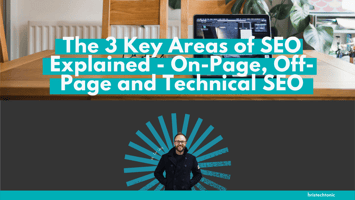Internal links are links between pages on the same website. These links allow users to navigate...
What Is On-page SEO?
How often are customers finding your business through search engine result pages (SERPs)? Over 53% of website traffic comes from organic search. In fact, 68% of experiences online begin with a search.
Search engine optimisation (SEO) can improve our Google ranking. You'll reach more customers and generate more leads. For better rankings, you need on-site and off-site SEO.
What is the difference between on-site SEO vs off-site SEO? Read on to learn about webpage optimisation today!
On-Site SEO vs Off-Site SEO
On-page SEO techniques are anything you can do on a webpage (your website) to improve your Google ranking. Off-page SEO involves optimisation techniques outside of your website. In other words, on-page SEO is internal while off-page SEO is external.
You need both types of SEO to rank higher on SERPs. Two other types of SEO are local and technical SEO.
Local SEO allows you to reach nearby consumers. You can create location-specific content or optimise your Google Business listing. Generating reviews can further improve your local rankings.
Technical SEO techniques involve optimising the backend of your website. Google prioritises websites that are:
- Fast
- Mobile-optimised
- User-friendly (following Google's Core Web Vitals)
- Secure
Using all four types of SEO creates a more comprehensive SEO marketing strategy. Together, these four strategies will improve your organic rankings. Over time, you could rank at the top of SERPs for specific keywords.
The Benefits
Investing in on- and off-page SEO will set your business up for lasting growth. The benefits of search engine optimisation include generating:
- Brand awareness and recognition
- Credibility
- Brand trust and loyalty
- Website traffic
- Conversions (website leads and sales)
SEO is a cost-effective digital marketing strategy. You won't have to pay to improve your organic rankings.
SEO can generate long-term benefits. Once you improve your organic rankings, it can take time for competitors to knock you down.
Ranking ahead of competitors will ensure customers find your brand during online searches first. You can generate website traffic and leads before competitors get the chance. You'll continue generating results over time.
Since SEO is cost-effective and long-term, you have the chance to improve your ROI. You'll gain a competitive advantage and experience growth.
To experience these benefits, consider partnering with a full-service digital marketing agency. They'll ensure you use proper on-page SEO techniques. They can apply off-page, technical, and local SEO strategies to improve your rankings.
What Is On-Page SEO?
Remember, on-page SEO involves optimising your website for search engines. Proper on-page SEO techniques can improve your rankings. Higher rankings ensure you reach customers who need your product or services.
Google considers on-page SEO elements, including keywords, to determine if a webpage or blog post matches a user's search intent. Search intent is usually:
- Navigational: for finding specific pages
- Informational: to learn something
- Commercial: for researching products/services
- Transactional: to complete specific actions
Understanding the user's search intent will ensure you create helpful, relevant content. Your website content will have a better chance of ranking on the first SERP.
This allows Google to prioritise "people-first content." If your content doesn't reflect on-page SEO best practices, it may not reach your ideal customers.
On-Page SEO Checklist
There are nine essential on-page SEO elements you'll need to improve your rankings. These include:
- Writing unique, fresh, relevant content
- Strategically placing target keywords
- Writing keyword-rich title tags
- Writing click-worthy descriptions
- Structuring content using headings and subheadings
- Optimising URLs
- Adding internal links
- Adding external links
- Optimising images
Here are a few tips that can streamline your webpage optimisation efforts.
Writing Content
Before writing website content, gather keyword research. Keyword research ensures you understand the user's search intent. Use tools such as:
- Answer the Public
- SEMRush
- Google Trends
- Keyword Planner
- Moz
When building a list of target keywords, look for long-tail keywords. These phrases should feature four or more words. They're more precise, making it easier for you to understand the search intent.
Check each keyword's search volume and keyword difficulty. It's more difficult to rank for competitive keywords. Long-tail keywords are usually less competitive.
For each primary keyword you select, choose three or four secondary keywords. This allows you to avoid keyword stuffing. Using your primary keyword too often could lead Google to penalise your content.
An SEO agency can complete this process for you. A competitor keyword analysis can elevate your business and rankings.
When writing blog content, incorporate EEAT:
- Experience
- Expertise
- Authority
- Trustworthiness
Demonstrating your experience and expertise will encourage readers to trust your content and advice. Gaining a consumer's trust can encourage conversions.
Keyword Placement
Google's bots will scan your content to determine what it's about (as will your readers). Strategically placing your keywords allows Google to understand the content. Your primary keyword should appear in the:
- URL
- Page title
- An H1 header
- The opening and closing paragraphs
- The body text
- An image's file name and alt text
- The SEO title and meta description
Proper keyword placement allows readers to determine if the post matches their search intent.
Writing Titles and Descriptions
The SEO title and meta description will appear on Google SERPs. These are pieces of HTML code that link readers to your content. If the title and description aren't compelling, readers won't click to read more.
When writing title tags, try to keep it brief. The text will appear incomplete if it's over 60 characters.
Make sure to include your primary keyword in both the title and description. This shows Google and users that it's relevant to the search.
Try to be unique. Avoid duplicating title tags. Instead, engage the reader.
Use an active voice to communicate your message clearly. Add a compelling call to action (CTA) to the description to encourage clicks.
Generating more clicks will improve your clickthrough rate. This can boost your organic rankings.
Structuring Content
Headers and subheaders can improve your content's readability. Ensuring the content is easy to read will encourage people to skim it. Otherwise, they may leave.
As people leave without exploring your site, your bounce rate will increase. This could cause your rankings to drop.
Headings allow Google to understand a page's hierarchy. Google's bots will have an easier time determining if the content matches a user's intent.
Use secondary keywords within your subheadings. This will help readers understand the information you intend to cover. It can also help content appear as featured snippets on SERPs.
Optimising URLs
Use URLs that don't look intimidating or cryptic. Instead, use words that are relevant to your content. This allows Google and readers to understand the post's context.
Avoid:
- Random numbers
- Publish dates
- Full sentences
Optimising URLs makes it easier for Google to match your content with relevant search queries.
Link Building
Your content should include internal and external links.
Internal links point readers to other pages on your website. As a component of on-page optimisation, this helps search engines understand a site's structure. Google will recognise how your pages relate to one another.
Internal linking will help Google crawlers discover and navigate your fresh content. It can signal to Google that the linked-to page is relevant and valuable.
Internal links direct readers to other pages on your site. This encourages them to remain on your website longer. Your dwell times will increase, improving organic rankings.
External links send readers to content beyond your website. You can use external links to boost your credibility. Gaining brand credibility encourages trust and loyalty to grow.
The user's online experience will improve. Offering a positive user experience further encourages brand trust.
Choose authoritative external links. Find trustworthy websites that relate to the post's context or your niche.
Write descriptive, natural anchor text. The anchor text will hold the link. This tells readers what to expect before they click.
Avoid making your content appear spammy. Balance the number and placement of these links within your content.
In time, other blogs will send readers to your content. This allows you to generate backlinks. Backlinks are one of Google's top ranking factors.
Generating backlinks can improve your Google ranking position. You'll generate more brand awareness, credibility, and traffic. Backlinks are a type of off-site SEO.
Optimise Images
Optimising images can improve your chances of ranking in Google Images. You can generate traffic as search engine users search for photos.
Optimise images on your website by writing a descriptive image alt text. The alt text is included in your HTML code. This can provide context for search engine crawlers.
It also ensures accessibility. People using screen readers can hear descriptions of your images.
When writing alt text:
- Keep it brief (below 125 characters)
- Include your primary keyword
- Exclude "image of" or "picture of"
Improving Webpage Optimisation
To recap, what is the difference between on-site SEO vs off-site SEO? On-site SEO involves optimising your website content for search engines. Off-site SEO focuses on external elements.
If you want to improve your website optimisation, partner with an industry expert. Working with BrisTechTonic gives you access to a suite of SEO services tailored to your needs.
Leverage my army of trusted freelancers to remain competitive. Want to reach position one on Google SERPs? Schedule your free discovery call today!




